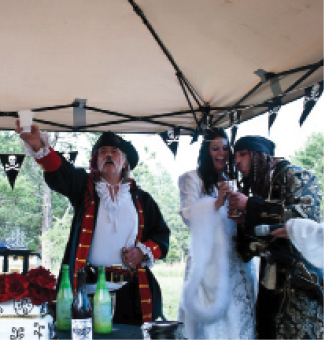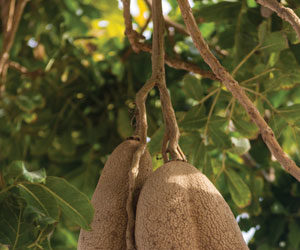
Driving down a dirt road surrounded by pine trees, we eventually reached the clearing. Ahead was no ocean, in fact we are hundreds of miles from the ocean. There are no ships, but dozens of pirates and wenches were assembled before us. The sound of music filled the air and pirate flags, fire pits, grills, and wedding decor made for a colorful vision.
What does this have to do with wine? Aren’t pirates known to drink rum? This was our daughter’s pirate themed wedding in the woods of Colorado and I had been asked to vint a special wine and provide homebrewed beer for the celebration.
This was all driven by the popularity of the Pirates of the Caribbean movies that ignited a bit of a pirate frenzy at the time. No group embraced it more than the Burners: The thousands of attendees of the annual Burning Man festival in the Nevada desert.
The happy couple at the center of this celebration and their friends were indeed Burners. All guests were to dress in their best pirate garb and come to party like it was 1699.
What manner of wine would be suitable for a gathering of pirates? It needed to be something special
and I wanted to provide some variety; at least a red and a white. It also had to somehow fit the Caribbean pirate theme.
I perused my recipes and checked the galley for supplies. I found plenty of frozen grapes from the previous year’s harvest. I chose Niagara, Pink Catawba, and Concord grapes to provide me with white and red grapes.
The white/green grapes had been separated from the pink/purple grapes; cleaned, culled, and treated with metabisulphite prior to freezing. I also had some Italian plums, which had like-wise been cleaned, culled, pitted, and treated.
So, a white, a red, and a plum wine it would be. But, how to make them fit the pirate theme? I dubbed them Wicked White, Rogue Red, and Plundered Plum.
I followed a similar procedure for each wine; for each pound of fruit, I added one pint of water, one cup of sugar, yeast nutrient, and pectic enzyme. This sat in the fermenter for about 24 hours before adding yeast.
As it fermented, I stirred and mashed the bag of fruit pulp daily. When fermentation was nearly complete, the pulp was removed and the must squeezed out. The wine was racked to a secondary to finish and clear. When it was time for bottling, I added sugar to taste and potassium sorbate to prevent further fermentation.
How did these wines taste? The white was crisp, slightly sweet, with the flavor and aroma of fresh apple and pear. The red had nice body, clear ruby red color, good balance between tart and sweet, and a dry finish. The plum wine was full-bodied and dark blood red; very sweet at the front with a fruity bitterness in back leaving a dryness not unlike the fresh plums themselves.
We made our way down to the party dome, amid pirate revelers eagerly awaiting to sample my wares. A dozen bottles of each wine, some homebrewed beers, and a cask of Pilsner were all downed with gusto and good cheer. Along with the bounty of succulent meats, seafood, and veggies rolling off the grills; the buccaneers and wenches had their proper fill of grub and grog. There may have been a flagon or two of rum as well.
Aye matey!






